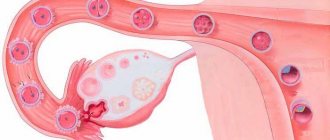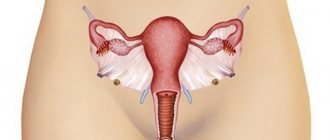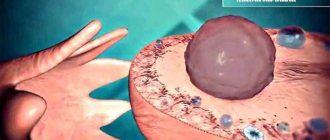Author: Volkova A.A., endocrinologist, practical experience since 2015. May, 2021.
Synonyms: rare periods, a variant of hypomenstrual syndrome.
ICD-10 code: N91.4
Secondary oligomenorrhea is an increase in the interval between menstrual bleeding, often in combination with a shortening of the bleeding period itself. It develops after the establishment of a normal menstrual cycle. Occurs on average in 2.5-3% of women. In addition to menstrual irregularities, it can be characterized by obesity, the development of male pattern hair, and mood instability. It is treated both medically (COC) and surgically, depending on the cause.
Classification
Secondary oligomenorrhea differs from primary in that the secondary form occurs against the background of an established cycle, and the primary form is observed in girls with a not yet established cycle.
There are different forms of secondary oligomenorrhea:
- shortened menstruation (duration of bleeding from several hours to 1-2 days);
- extended interval between menstruation (from 40 days to six months)
- mixed variant, in which shortened bleeding is combined with a large gap between them (most common).
Additionally, secondary oligomenorrhea is divided into physiological and pathological.
Important! Physiological oligomenorrhea can be considered during lactation, at the onset of menopause. In all other cases, the symptom is pathological.
Description of the disease
Oligomenorrhea is a disorder in the menstrual cycle when the period between menstruation stretches for more than thirty-five days, so that the normal cyclicity is shifted. Such bleeding can last several hours, or maybe two or three days; it is scanty and more like a slightly blood-stained discharge. Most often, this problem occurs in girls with early menstruation, girls and young women. Doctors also call oligomenorrhea rare menstruation.
Important! Oligomenorrhea is considered cured when a regular menstrual cycle occurs with a frequency of one menstruation every 30-35 days.
This cyclicity should be observed for at least one year - then the woman is transferred to gynecological examinations once a quarter, and a year later - once every six months.
Causes and risk factors
Secondary oligomenorrhea in most cases develops as a result of exposure to various negative factors on the female body. The most common reasons are:
- acute and chronic infectious processes affecting the uterus and ovaries (gonorrhea, chlamydia, candidiasis, ureaplasmosis, genital herpes);
- diseases of the reproductive system of an inflammatory or traumatic nature (salpingitis, endometritis, oophoritis, myometritis);
- various stressful effects, nervous shock, the presence of certain mental disorders (bulimia, anorexia);
- the influence of negative environmental factors (living in an environmentally unfavorable area, working in hazardous industries, etc.);
- decompensated (untreated) diseases of the pancreas, adrenal glands, thyroid gland (diabetes mellitus, adrenal insufficiency, hypo- and hyperthyroidism, etc.);
- surgical interventions on the uterus and ovaries, including abortions;
- disturbances in the functioning of the pituitary gland or hypothalamus, due to which the hormonal regulation of the body generally suffers;
- diseases of the heart and blood vessels (with diseases of the cardiovascular system, the blood supply to the genital organs may be disrupted, which leads to a disorder in their functioning, and the body as a whole is weakened).
Doctors also identify risk factors that increase the risk of developing oligomenorrhea, but do not lead to it in 100% of cases. Among these factors:
- unfavorable environmental influences;
- regular stress;
- habit of eating poorly, going on irrational diets;
- taking hormonal medications without a doctor’s recommendation or neglecting the doctor’s recommendations;
- lack of vitamins;
- being overweight;
- sudden climate changes.
Professional female athletes are also at risk, as they constantly experience not only severe stress, but also have to cope with high physical activity.
Symptoms
The main symptom of secondary oligomenorrhea is short periods or a long interval between menstrual bleeding. A significant number of women ignore this symptom for a long time, not realizing that this is not a normal option, but a pathology. After all, the rarity or short duration of menstrual bleeding indicates that the uterine endometrium is renewed slowly and does not grow intensively enough. Such a change in the organ threatens infertility. Often a woman thinks about the need to visit a doctor for oligomenorrhea only after unsuccessful attempts to become pregnant and carry a child to term.
In addition to problems with pregnancy, the following symptoms may occur due to hormonal imbalance:
- disturbances in fat metabolism develop, which leads to the development of obesity;
- when there is an excess of testosterone in the female body, the figure changes to a male type (broad shoulders, narrow hips);
- acne appears on the skin, acne develops;
- hirsurtism develops (hair on the face, neck, back, abdomen according to the male type of hair growth), observed in 20% of patients;
- Libido decreases, sexual desire becomes less pronounced;
- There are sudden mood swings, increased nervousness and irritability.
In case of secondary oligomenorrhea, the symptoms may not cause significant discomfort to the woman for a long time, which is why she postpones seeing a doctor.
Diagnosis of secondary oligomenorrhea
Secondary oligomenorrhea is diagnosed based on a combination of medical history, symptoms, results of laboratory and instrumental studies. During a conversation with the patient, the doctor clarifies when the first menstruation (menarche) occurred, how quickly the menstrual cycle became regular, whether the woman suffers from symptoms of premenstrual syndrome, whether she has a history of diseases of the reproductive organs or abortions. An examination in a gynecological chair is required.
From the studies applied:
- Ultrasound of the pelvic organs (can be performed both transabdominally and transvaginally, the second option is preferable due to its greater information content) - pay attention to the size of the uterus and its appendages, their shape, structure;
- analysis of sex hormones - assess the level of progesterone, prolactin, estradiol, LH, FSH (an LH level of more than 15 mU/l should alert you outside the peak of ovulation, on days 1-14 of the cycle, as well as at the beginning of menstruation);
- hysterosalpingography is a method that allows you to assess the patency of the fallopian tubes;
- a group of tests to detect sexually transmitted diseases (chlamydia, gonorrhea, syphilis, etc.).
If a tumor of the pituitary gland is suspected, a woman may be recommended to have an MRI of the brain. If a disease of the adrenal glands is suspected, a urine test for 17-ketosteroids is taken, and if a pathology of the thyroid gland is suspected, a blood test is taken for thyroid hormones.
Physiology of regulation of menstrual cycles
Menstrual cycles are repeated cyclical changes in the female body, especially in various parts of the reproductive system. Its culminating external manifestation is menstruation, which repeats at a certain interval throughout the entire reproductive period, except for periods of pregnancy and lactation. Failure of these processes leads to the development of disorders, including oligomenorrhea. After the first menstruation (menarche), which usually appears at 10-12 years of age, the regularity of the cycles can be established over the course of 1-1.5 years.
The normal course and cyclicity of these processes, accompanied by changes throughout the body, is ensured by a single neurohormonal system, consisting of central (unifying) and peripheral effector (executive) structures, as well as intermediate links. In the mechanism of reproductive regulation, 5 levels are conventionally distinguished, which interact with each other in accordance with the principles of positive and negative direct and feedback connections.
Highest or first level
Represented by the cerebral cortex and some other structures of the brain. They participate in the perception and corresponding influence on other parts of the reproductive system, depending on the frequency, severity and duration of exposure to external (severe stress, instability of the psycho-emotional sphere, etc.) and internal stimuli. In the latter case, this occurs with the help of specific receptors for estrogens, androgens and progesterone. In response to the action of stimuli, biologically active substances are synthesized, released and undergo biochemical transformations in these brain structures, affecting the corresponding function of another brain formation - the hypothalamus.
Second level
The hypothalamus, as a neuroendocrine structure, is the second level of regulation. It has the properties of both neurons that reproduce electrical impulses and cells that secrete the hormonal substances liberins (stimulating) and statins (blocking). The activity of the hypothalamus depends both on the regulatory influence of the first level structures and on the content of sex hormones in the blood. Gonadotropic liberins of the hypothalamus are collectively called gonadotropin-releasing hormone (GnRH). Its secretion is programmed genetically and is circoral (pulsating) in nature. The maximum activity of the hypothalamus lasts several minutes, activity intervals range from 1 to 3 hours, which is also influenced by the concentration of estradiol in the blood during the luteal or follicular phase of the menstrual cycle.
Third level
The anterior lobe of the pituitary gland is the third level of neuroendocrine regulation. This part of the brain secretes hormones:
- FSH (follicle-stimulating), stimulating the growth and maturation of follicles in the ovaries;
- LH (luteinizing hormone), which together with the first one promotes the production of progesterone;
- prolactin, which controls the release of progesterone by the corpus luteum into the blood, as well as stimulating the growth of the mammary glands and regulating lactation;
- TSH (thyroid-stimulating), STH (somatotropic) and ACTH (adrenocorticotropic).
Only with a balanced secretion of these hormones is it possible for adequate functioning of the reproductive system, the establishment of a regular menstrual cycle and the absence of such disorders as oligomenorrhea, amenorrhea, hypomenorrhea, etc.
Fourth level
Consists of peripheral endocrine organs, which include the ovaries, thyroid gland and adrenal glands. The ovaries, in which follicles grow and mature, sex hormones are synthesized, and the corpus luteum is formed, play a major role. Hormones synthesized in the ovaries are decisive not only in the functional changes of the reproductive system itself, but they also have an active influence on metabolic processes in tissues and organs that have receptors for sex hormones, aminopeptides, insulin and glucagon.
Fifth level
It consists of the mucous membrane of the vagina, the uterus, especially its mucous membrane (endometrium), in which cyclic processes are most expressed, fallopian tubes and mammary glands. Cyclic changes in the endometrium, consisting of cell proliferation, secretion and menstruation itself, depend both on the concentration of sex hormones in the blood and on the state of the tissue receptor apparatus for sex hormones.
These levels form the hypothalamic-pituitary-ovarian axis. The principles of direct and reverse interaction through specific hormone receptors at all levels ensure cyclicality and adequate functioning of the reproductive system.
Similar article - White plaque in the mouth of a baby
By “direct” connection we mean the stimulating effect of the hypothalamic region of the brain on the pituitary gland with the subsequent synthesis of sex hormones in the ovaries, by “reverse” - the influence of the level of concentration of sex hormones on the hypothalamus and pituitary gland.
One of the main general indicators, which reflects the interaction of different levels of the hypothalamic-pituitary-ovarian axis and the possibility of implementing the main function of the body's reproductive system, is the menstrual cycle. Its character makes it possible to clinically determine the level of condition of the reproductive system, due to the correct relationships in the hypothalamus-pituitary-ovarian system.
Thus, NMCs of the oligomenorrhea type, like other types of these disorders, can be provoked by factors that cause disturbances in the interaction of parts of the neuroendocrine system at one or several levels.
Treatment
Treatment of secondary oligomenorrhea should be comprehensive and selected depending on the cause of the disease. Therapy is jointly selected by a gynecologist and an endocrinologist. Treatment is possible with conservative and surgical methods.
Conservative therapy
Based mainly on the use of hormonal drugs. The purpose of the medications is to normalize the ratio of hormones and start the ovulation process. For this purpose, progesterone preparations (Duphaston, Inzhesta, Utrozhestan, etc.) or combined oral contraceptives are prescribed. They are suitable for women who do not plan to become pregnant or give birth in the near future. Progesterone preparations are taken in a course of 10-12 days a month until menstruation returns to normal. Combined oral contraceptives are taken according to standard regimens selected by doctors.
If a woman wants to get pregnant, she undergoes drug stimulation of ovulation under the supervision of a doctor.
In addition to drug treatment, it is necessary to eat well and rest, give up bad habits, and monitor your weight.
If it is determined that the cause of oligomenorrhea is an infectious disease, an antiviral, antifungal or antibacterial drug is selected with the help of a doctor, depending on the specific causative agent of the disease. In addition to the treatment of infection, drugs that stimulate the immune system, anti-inflammatory drugs, and physiotherapeutic procedures are used.
Surgical treatment
Surgical treatment of secondary oligomenorrhea is indicated for women in whom drug therapy does not produce results.
The operation is performed for polycystic ovary syndrome. Today, doctors mainly perform sectoral resection of the ovary with cauterization, removing the part on which the largest number of cysts are found. The operation is performed laparoscopically. The recovery period takes 4-6 weeks.
What is oligomenorrhea: treatment features, is it possible and how to get pregnant with rare periods
The female reproductive system is designed in such a way that it independently regulates the cyclical processes that update it approximately once a month, and, if necessary, even controls a woman’s behavior by releasing certain hormones.
This system is so delicate that the slightest stress to which the female body is exposed can cause disruptions in its functioning. When cyclicity is disrupted, problems with conception, hormonal changes and other problems of a purely female nature appear.
To know what to do in case of problems with the functioning of the body, you need to understand the essence of the processes of menstruation, ovulation and be able to listen to your body.
Now we will understand what a menstrual cycle disorder, known as oligomenorrhea, is, we will find out the causes of this disease, methods of its treatment and we will answer the most important question - will a woman with rare menstruation be able to get pregnant.
Description of the disease
Oligomenorrhea is a disorder in the menstrual cycle when the period between menstruation stretches for more than thirty-five days, so that the normal cyclicity is shifted.
Such bleeding can last several hours, or maybe two or three days; it is scanty and more like a slightly blood-stained discharge. Most often, this problem occurs in girls with early menstruation, girls and young women.
Doctors also call oligomenorrhea rare menstruation. Important! Oligomenorrhea is considered cured when a regular menstrual cycle occurs with a frequency of one menstruation every 30-35 days.
This cyclicity should be observed for at least one year - then the woman is transferred to gynecological examinations once a quarter, and a year later - once every six months.
Kinds
This disease is classified depending on the causes of its occurrence and the period of development at which it occurs. Different types of oligomenorrhea are characteristic of different age categories of women.
Primary
After the first bleeding (menarche), cyclicity in girls should be established within the first year and a half. If this does not happen, primary oligomenorrhea, also called congenital, is diagnosed.
This diagnosis is easier to correct than the secondary one, since the girl’s body is at a developing stage and the hormonal levels in it are not yet stable. It is corrected with auxiliary drugs, the level of testosterone, which disrupts female sexual function, is lowered, and the ovaries begin to work in the correct mode.
If infrequent menstruation is not corrected before adolescence, it will continue into a girl’s adult life and interfere with her reproductive function.
Secondary
This disease is called acquired because its symptoms appear after the formation of normal cyclicity.
Sometimes secondary oligomenorrhea can be a harbinger of menopause - in this case, the cause of the appearance is the same hormonal changes and this condition is considered physiologically normal.
If a woman is young, then menstrual irregularities are considered a disease. It is quite rare - only two percent of women under the age of 40 experience such symptoms.
Causes of the disease
If we talk about the primary form, its cause is congenital disorders of the development of the reproductive system in girls, which are formed in the womb, such as underdevelopment of the uterus (infantilism). As for the secondary, acquired form, it is provoked by malfunctions in the hypothalamic-pituitary-ovarian system.
They arise as a result of significant stress - viral and bacterial infections, acute malnutrition, nervous exhaustion, injuries to the abdominal cavity and genital organs. A polluted environment and an unfavorable type of emotional climate also lead to NMC (menstrual cycle disorders) as they worsen.
If you have recently moved to a new country with an unusual climate or exposed yourself to excessive physical activity, oligomenorrhea will not be long in coming. Diseases of the endocrine system - be it the ovaries or the adrenal glands - have an equally negative effect on the female reproductive system.
If you have a family history of oligomenorrhea, it can be passed on to you genetically. Also, secondary oligomenorrhea occurs as a complication of polycystic disease or hypoplasia, endometriosis.
https://youtu.be/4XHbKXQxF8Q
It is provoked by surgical interventions in the reproductive system, such as endometrial curettage, abortions, mini-abortions and medical operations on the uterus and ovaries. Menstrual irregularities are not at all a sign of an ill-conducted operation.
This is an individual reaction to an unusual stimulus, which may or may not show itself.
Oral contraceptives with estrogens, which affect hormonal levels, synthetic hallucinogenic and narcotic drugs, as well as incorrect treatment with hormone-containing drugs are another factor affecting the cyclicity of menstruation.
Oligomenorrhea and pregnancy
The success of pregnancy with this disease depends on its severity.
For example, if, with disrupted menstruation, there are additionally problems with the renewal of the uterine epithelium or polycystic ovary syndrome is diagnosed, the chances of a successful pregnancy are negligible, and by becoming pregnant, a woman endangers both her life and the life of the unborn baby. In this case, no therapy justifies the result - you are better off thinking about surrogacy or adopted children.
If rare menstruation is caused by uterine infantilism, and the rest of the reproductive system functions relatively normally, then proper treatment and medical supervision will ensure normal pregnancy and the birth of a healthy child. According to WHO statistics, oligomenorrhea provokes complete infertility in fifteen percent of cases, and twenty percent of women can become pregnant with oligomenorrhea on their own, since in this case everything is very individual.
Signs and symptoms
The main symptom of oligomenorrhea is rare, scanty menstrual flow. Menstruation itself can occur every fortieth day, or three or four times a year - it all depends on the degree of development of the disease. Signs include increased hair growth (hirsutism), which is caused by hormonal changes.
Hair begins to appear on the face, limbs, stomach and even chest, that is, completely male type. Important! If a patient has nervous disorders, in addition to standard therapeutic and hormonal treatment, she is prescribed sedatives and mild antidepressants to improve morale.
The mass of adipose tissue increases and is deposited throughout the body, as lipid metabolism is disrupted. The physique changes, it becomes similar to a man’s, with expanding bone tissue and growing muscles. Skin problems appear - a pustular rash on the face, neck and back, which in young girls is confused with teenage acne.
As for internal symptoms, sexual desire is disrupted - libido becomes less pronounced, craving for men decreases.
How is the diagnosis carried out?
If you notice similar symptoms in yourself, make an appointment with a gynecologist and endocrinologist, they will definitely determine the cause of the problems that have arisen.
Diagnosis in women is carried out in a clinic and begins with a gynecological examination for oligomenorrhea and consultation with a psychologist, so get ready for examinations - such communication will take some time.
It is very important to determine the emotional state of the patient and her attitude towards her condition before making a diagnosis and prescribing treatment. Find out whether it is possible to get pregnant before and after your period.
Then a referral is issued for additional diagnostics, which begins with drawing up a chart of basal temperature, ultrasound and MRI of the pelvic organs. A blood test is required to determine the level of sex and pituitary hormones. Sometimes an additional urine test is taken to check the functioning of the adrenal glands. Based on the data received, your treating gynecologist will make an accurate diagnosis and offer treatment options.
How to get pregnant if diagnosed: treatment of oligomenorrhea
Treatment is carried out based on the reasons that provoked this disease and the age of the patient. There are medicinal treatment methods, as well as folk remedies for improving the condition of the reproductive system and adjusting lifestyle, which sometimes works better than all prescribed medications.
Modern medicine
It has a wide range of hormone-containing drugs that can regulate hormonal levels. Oddly enough, oral contraceptives, usually used to prevent pregnancy, are prescribed to treat infrequent periods.
The fact is that they contain standardized doses of estrogen, which, if used correctly, normalizes female sexual function and improves the regularity of menstruation. For oligomenorrhea, it is possible to use gonadotropic drugs and drugs with an immunomodulating effect for treatment.
To further strengthen the reproductive system, doctors prescribe vitamin complexes, which are taken simultaneously with estrogen-containing medications. Physiological treatment methods are also used.
These include: acupuncture, reflexology, gynecological massage, which is performed by a specialist, and special gymnastic exercises, which, according to the instructions, are performed by the patient herself.
Surgical interventions are used extremely rarely - they are resorted to only if a serious pathological dysfunction of the ovaries, uterus or malignant tumors is detected that interfere with the normal course of the menstrual cycle.
The most common operation for the treatment of rare periods is called diathermocoagulation - this is the cauterization of ovarian tissue with high-frequency electric current. True, such an operation is indicated only for those women who have given birth before - young girls preparing to conceive their first child may have problems with the dilatation of the cervix during childbirth. If the cause of the cycle disruption is obesity, or, conversely, excessive exhaustion, a corrective diet is prescribed. A set of physical exercises is selected to reduce body weight or increase the volume of muscle tissue. As soon as the body mass index approaches normal, there is a normalization of the regularity of bleeding.
Folk remedies
They are usually used as an adjunct to drug treatment. Traditional treatment methods strengthen the female reproductive system as a whole and stimulate it without having any specific effect. The most popular and safest folk remedies are medicinal decoctions of herbs and plant bark.
A decoction of fragrant rue and parsley seeds in a 1:1 ratio is poured into a glass of boiling water, left for fifteen minutes and filtered through cheesecloth or a sieve. You need to drink this decoction half an hour before meals three times a day. Decoctions of wormwood, European dodder and quinoa are prepared in the same way.
Two teaspoons of these herbs are poured into a glass of boiling water, left for half an hour, and then divided into three parts and drunk, mixed with a glass of warm water, three times a day. There are such complex herbs as shepherd's purse, mistletoe and bird's knotweed - these herbs are taken in a teaspoon each, boiled for ten minutes, then left for two and a half hours and drunk half a glass on an empty stomach.
This decoction should be stored in the refrigerator, tightly closed. Alcohol tinctures are prepared with oregano: one part of the herb requires ten parts of alcohol or vodka. The infusion process lasts two weeks, the container with the tincture is constantly shaken. Drink an alcoholic infusion once a day, thirty drops at a time, after a morning meal.
Important! Many doctors associate rare menstruation with the development of pathological diseases of the reproductive system. Only a complete diagnosis, including MRI and ultrasound, will provide a clear understanding of the causes of this disorder.
Prevention
To prevent the occurrence of oligomenorrhea or prevent its re-development, you need to adhere to the basic principles of a healthy lifestyle. Do not limit yourself in rest and ensure proper sleep.
Eat more calories if you are underweight, and reduce calories by increasing the proportion of vegetables and fruits in your diet if you suffer from excess fat tissue.
Engage in moderate physical activity—walk the steps instead of the elevator, use a shopping cart instead of a trolley at the supermarket, wet clean on weekends with a cloth to bend over as much as possible, and wash light items by hand.
You will be surprised at the beneficial effects such seemingly insignificant activity has. Go to an appointment with a gynecologist at least once every six months. Make this a useful habit - then it will be much easier to notice changes in the reproductive system in a timely manner.
Your health is your greatest asset, which you must strictly monitor. As soon as you notice strange symptoms or feel the slightest discomfort, know that your body is signaling you about problems in its functioning.
Do not ignore these signals, but reconsider your lifestyle or seek qualified medical help. Yes, you can be prescribed a great many tests and undergo several examinations - precaution has never hurt anyone.
But you will know what processes are happening in your body, and at the first signs of disturbances, you will return your health to normal.
Knowing the symptoms and signs of oligomenorrhea and being able to recognize them in yourself in time, you will ensure the health of your reproductive function and will live a full sexual life for many years.
Source: https://agu.life/bok/1553-chto-eto-takoe-i-mozhno-li-zaberemenet-pri-oligomenoree.html
Complications, prognosis and prevention
The main complication of secondary oligomenorrhea, which is most feared, is infertility. According to statistics, in approximately 40% of cases a woman is not able to conceive or bear a child precisely because of the presence of secondary type oligomenorrhea. Also, hormonal imbalance in general negatively affects the body, increasing the likelihood of developing cancer of the reproductive system.
With timely initiation of treatment, the prognosis for secondary oligomenorrhea is favorable. A significant number of women, under the supervision of a doctor, manage to normalize hormone levels and regulate the menstrual cycle.
Prevention of the secondary form of oligomenorrhea is based on maintaining a healthy lifestyle, timely treatment of identified diseases, and regular preventive examinations with a gynecologist.











